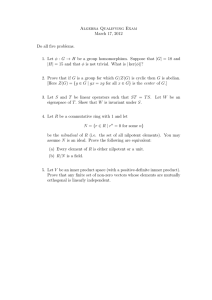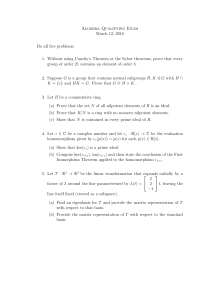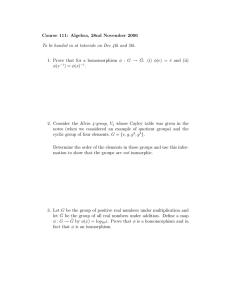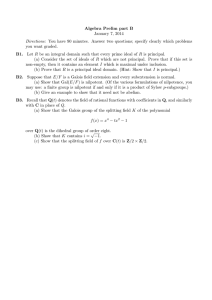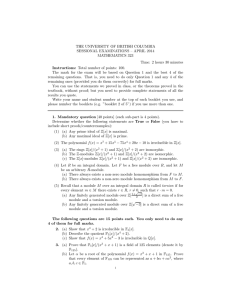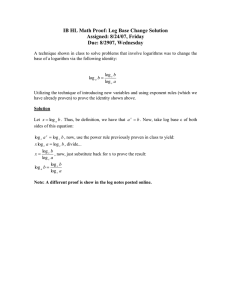Math 110B HW §6.2 – Solutions 5. Suppose that θ is an
advertisement
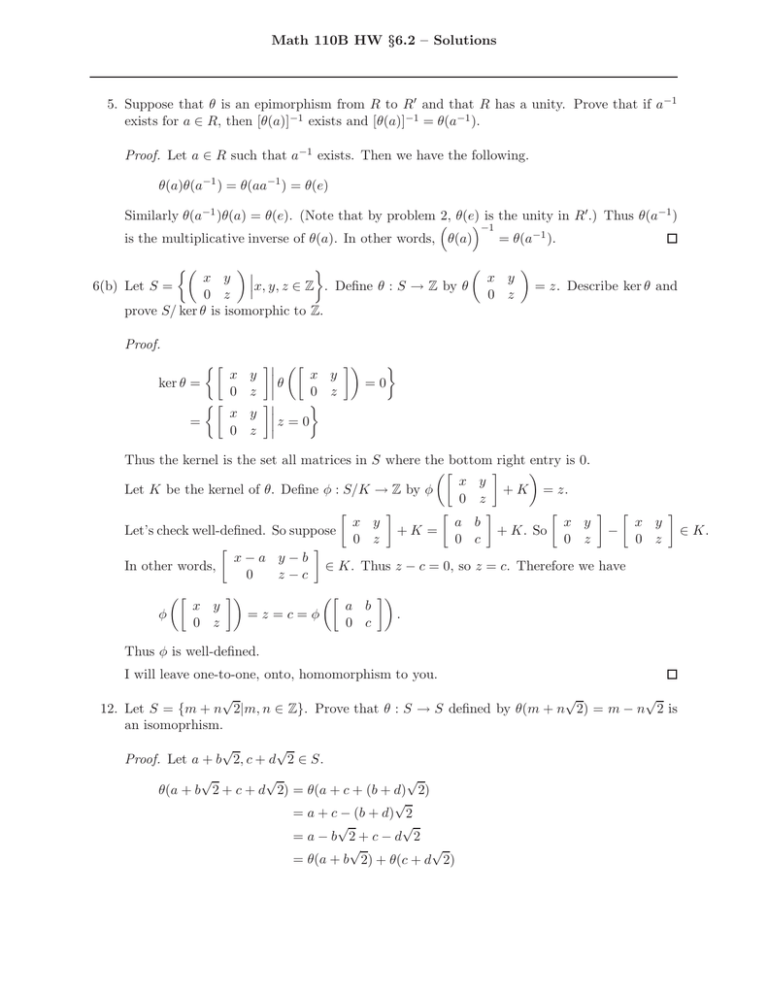
Math 110B HW §6.2 – Solutions
5. Suppose that θ is an epimorphism from R to R0 and that R has a unity. Prove that if a−1
exists for a ∈ R, then [θ(a)]−1 exists and [θ(a)]−1 = θ(a−1 ).
Proof. Let a ∈ R such that a−1 exists. Then we have the following.
θ(a)θ(a−1 ) = θ(aa−1 ) = θ(e)
Similarly θ(a−1 )θ(a) = θ(e). (Note that by problem 2, θ(e) is the unity in R0.) Thus θ(a−1 )
−1
is the multiplicative inverse of θ(a). In other words, θ(a)
= θ(a−1 ).
x y x y
y,
z
∈
Z
.
Define
θ
:
S
→
Z
by
θ
= z. Describe ker θ and
x,
0 z
0 z
prove S/ ker θ is isomorphic to Z.
6(b) Let S =
Proof.
x y
ker θ =
=0
θ
0 z
x y z
=
0
=
0 z x y
0 z
Thus the kernel is the set all matrices in S where the bottom right entry is 0.
x y
Let K be the kernel of θ. Define φ : S/K → Z by φ
+ K = z.
0 z
x y
a b
x y
x y
Let’s check well-defined. So suppose
+K =
+ K. So
−
∈ K.
0 z
0 c
0 z
0 z
x−a y−b
In other words,
∈ K. Thus z − c = 0, so z = c. Therefore we have
0
z−c
φ
x y
0 z
=z=c=φ
a b
0 c
.
Thus φ is well-defined.
I will leave one-to-one, onto, homomorphism to you.
√
√
√
12. Let S = {m + n 2|m, n ∈ Z}. Prove that θ : S → S defined by θ(m + n 2) = m − n 2 is
an isomoprhism.
√
√
Proof. Let a + b 2, c + d 2 ∈ S.
√
√
√
θ(a + b 2 + c + d 2) = θ(a + c + (b + d) 2)
√
= a + c − (b + d) 2
√
√
= a−b 2+c−d 2
√
√
= θ(a + b 2) + θ(c + d 2)
√
√
√
θ((a + b 2)(c + d 2)) = θ(ac + 2bd + (ad + bc) 2)
√
= ac + 2bd − (ad + bc) 2
√
√
= (a − b 2)(c − d 2)
√
√
= θ(a + b 2)θ(c + d 2)
Thus θ is a homomorphism.
√
√
√
√
√
Let x + y 2 ∈ S. Then θ(x − y 2) = θ(x + −y 2) = x − (−y 2) = x + y 2. Thus θ is onto.
√
√
√
√
Suppose θ(r + s√ 2) = θ(w + z 2) for some √
r, s, w, z ∈ Z. Then r − s 2 = w − z 2. So
r − w = (s − z) 2. If s − z 6= 0, then (s − z) 2 is irrational, but r − w is rational, which is
a contradiction. Thus s − z must be 0. So s = z and so r = z. Therefore θ is one-to-one.
Hence θ is an isomorphism.
√
m 2n m, n ∈ Z and R0 = {m + n 2|m, n ∈ Z}. Prove that R and R0 are
14. Let R =
n m
isomorphic.
√
m 2n
0
Proof. Define θ : R → R by θ
= m + n 2.
n m
I’ll leave it to you to show that θ is an isomorphism.
18(b) Suppose θ : R → R0 is a homomorphism. Prove that if x ∈ R is nilpotent, then θ(x) is
nilpotent in R0 .
Proof. Let x ∈ R be nilpotent. Then xn = 0 for some n ∈ N. Then we have the following:
θ(x)n = θ(xn ) = θ(0) = 0
Thus θ(x) is nilpotent.
25. Assume that θ is an epimorphism from R to R0. Prove the following.
(a) If I is an ideal of R, then θ(I) is an ideal of R0 .
(b) If I 0 is an ideal of R0, then θ−1 (I 0) is an ideal of R.
Proof. Let θ : R → R0 be an epimorphism and let I be an ideal in R and I 0 be an ideal in R0.
(a) Since 0 ∈ I, θ(0) ∈ θ(I). Thus θ(I) 6= ∅.
Let a0 , b0 ∈ θ(I). Since θ is onto, there exists a, b ∈ R such that θ(a) = a0 and θ(b) = b0.
Then we have the following.
a0 − b0 = θ(a) − θ(b) = θ(a − b) ∈ θ(I)
Let r0 ∈ R0. Since θ is onto there exists r ∈ R such that θ(r) = r0 . Then r0a0 =
θ(r)θ(a) = θ(ra) ∈ θ(I). Similarly a0 r0 ∈ θ(I).
Thus θ(I) is an ideal in R0.
(b) Since θ(0R ) = 0R0 ∈ I 0, 0R ∈ θ−1 (I 0). Thus θ−1 (I 0) 6= ∅.
Let a, b ∈ θ−1 (I 0). So θ(a), θ(b) ∈ I 0 , thus θ(a − b) = θ(a) − θ(b) ∈ I 0 . Therefore
a − b ∈ θ−1 (I 0).
Let r ∈ R. Then θ(ra) = θ(r)θ(a) ∈ I 0 since θ(a) ∈ I 0. Therefore ra ∈ θ−1 (I 0). Similarly
ar ∈ θ−1 (I 0).
Thus θ−1 (I 0) is an idean in R.
